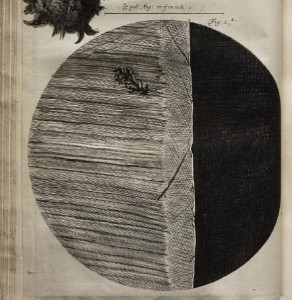Different concepts of the microscope in the 1660s
A guest post by Ian Lawson from the University of Sydney.
Ian Lawson writes…
Margaret Cavendish’s Observations upon Experimental Philosophy (1666) was a direct criticism of the Royal Society, largely focused on their most prolific work to that date – Robert Hooke’s Micrographia (1665). Cavendish was no fan of experimental philosophy generally, thinking it likely to lead to civil strife, and needing in any case to be guided by speculative thought, she criticised microscopes specifically for a few particular reasons:
- They’re difficult to make and use;
- They’re not very useful (Cavendish asks if observing a louse through a microscope can prevent it from biting); and, relatedly
- They distort nature.
This last, I would like to suggest, points to a different way of understanding and conceptualising the instrument to that of the Society microscopists (I am thinking particularly of John Wilkins, Christopher Wren, and Hooke).
Cavendish writes:
- I do not say, that no glass presents the true picture of an object: but only that magnifying, multiplying, and the like optic glasses, may, and do oftentimes present falsely the picture of an exterior object; I say, the picture, because it is not the real body of the object which the glass presents (pp. 50-51).
A louse, viewed under the microscope, looks like a lobster, and a sharp knife looks blunt. “[I]f the edge of a knife or the point of a needle were naturally and really so as the microscope presents them, they would never be so useful as they are” (p. 51). This is of course a direct reference to Hooke – a needle and a razor were the first two observations in his Micrographia.
Hooke likewise admits that if the razor were “really such as it appear’d through the Microscope, it would scarcely have serv’d to cleave wood, much less to have cut the hair of beards.” Unless, he continues, it were used
- after the manner Lucien merrily relates Charon to have made use of, when with a Carpenter’s Axe he chop’d off the beard of a sage Philosopher, whose gravity he very cautiously fear’d would indanger the oversetting of his Wherry (p. 5).
Hooke’s razor, though lacking a knife’s sharp edge, still has the capacity to rob a philosopher of his wisdom, by showing intuitive assumptions are unfounded. Cavendish appears to suggest there is one scale that an object exists ‘naturally’ at. On the other hand Hooke, Wilkins, and Wren emphasise the contingency of human senses:
- [I]f there were another Species of Intelligent Creatures in the World, they might have quite another kind of Apprehension of the same thing, and neither [theirs nor ours] perhaps as they ought to be.
(Hooke, General Scheme, or Idea of the Present State of Natural Philosophy, p. 8)
The Royal Society microscopists didn’t so much see themselves as altering the objects they were looking at, but rather modifying their own senses. They enter the micro-world, and present the razor as it would seem to someone the size of an insect. It may not retain its traditional use at this scale, but it is the observer who has been distorted rather than the object.
I’m not really sure how illustrative a difference this is to point out, but my feeling is it is tied in with a number of related themes and can possibly help to shed light on them: optimism for the new optical technologies; the new optics of Kepler and Descartes and the naturalisation of vision; experimental as opposed to mechanical philosophy; and Hooke’s approach to instruments more generally.


